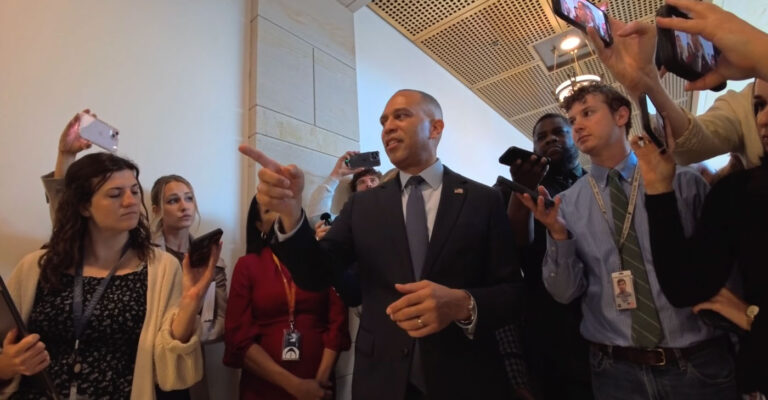By Lauren Burke
“Democrats are going to take back control of the United States House of Representatives. It’s the reason why we see Republicans in full-blown panic right now,” House Democratic Leader Hakeem Jeffries to reporters on Capitol Hill on Oct. 22. Democrats have been strategizing on redistricting strategy with leaders in Democratic states since Republicans in Texas. “We’ve never seen this level of extraordinary gerrymandering attempts take place across the country. Why do you think it’s happening? It’s happening because the Republican ship is sinking. It’s sinking right now because they failed to deliver anything for the American people. Just pay attention to what’s going to happen two weeks from now in Virginia,” Leader Jeffries asserted. With the likelihood that the U.S. Supreme Court will destroy Section 2 of the 1965 Voting Rights Act, events are moving quickly, and now Democrats in Virginia are set to enter the war on maps and redistricting. In August, Republicans in Texas, led by Donald Trump, changed their maps to target congressional seats held by Black Democrats.
In mid-2025, Trump publicly urged Texas Republicans to focus on a rare mid-decade redistricting of congressional maps. “We have an opportunity in Texas to pick up five seats. We have a really good governor, and we have good people in Texas. And I won Texas,” Trump told CNBC’s Squawk Box on August 5. Democrats in Illinois, California, Maryland, Colorado, New York, Oregon, Washington, and Virginia have been in discussions on possible districting to counter Trump-led Republican moves to eliminate congressional seats. Trump’s directive to Republicans in Texas quickly turned into a decision by the Texas GOP to change the congressional maps in a way that would make it much harder for three Black members of Congress to win. They include the congressional seats now held by Reps. Al Green (D-TX-9), Jasmine Crockett (D-TX-30), and Marc Veasey (D-TX-33). On top of the Republican attempts to control the 2026 elections by eliminating the seats of Black members of Congress, the U.S. Supreme Court, controlled by Republican nominees, is set to destroy Section 2 of the 1965 Voting Rights Act.
Section 2 of the Voting Rights Act is one of the most powerful protections against racial discrimination in voting. Section 2 prohibits any voting practice or policy that results in the dilution of voting power based on race. Unlike other parts of the law, Section 2 applies nationwide and allows individuals and groups to challenge maps that decrease Black voting power and election rules in court. It has been crucial in ensuring fair representation for Black, Latino, and other minority voters—especially since the Supreme Court weakened Section 5 of the Voting Rights Act in 2013. Section 5 of the Voting Rights Act was designed to prevent racial discrimination before it happened by requiring certain states and localities—mostly in the South with histories of voter suppression—to get federal approval, or “preclearance,” before changing any voting laws or practices. This safeguard ensured that new election rules, district maps, or voting procedures did not weaken minority voting power. But in 2013, the Supreme Court’s Shelby County v. Holder decision ended Section 5’s enforcement by striking down the formula for preclearance, which led to many Black communities becoming once again vulnerable to discriminatory voting practices.
In the 2013 ruling striking Section 5, Republican appointed U.S. Supreme Court Chief Justice John Roberts argued that Section 5 of the Voting Rights Act was no longer necessary because the conditions that once justified it—widespread, state-sponsored racial discrimination in voting—had largely disappeared. Roberts maintained that America had changed and no longer needed extraordinary federal intervention in election laws. But actions in Republican controlled southern states proved that Roberts’ argument against Section 5 was wrong.
In North Carolina, in August 2013, the legislature passed House Bill 589, which reduced early voting, eliminated same-day registration, banned out-of-precinct voting, and imposed a strict photo ID requirement. The changes specifically impacted voting rules that Black voters were utilizing. In Alabama, a new photo‐ID law was implemented in 2014 that significantly restricted the types of identification accepted (eliminating options like Social Security cards, birth certificates, EBT cards), soon after the Shelby decision. In Texas, officials immediately moved to enforce a strict voter‐ID law the day of the Shelby decision, which had previously been blocked under pre‐clearance. In Georgia, the passage of the Election Integrity Act of 2021 (also known as Senate Bill 202) imposed limits on absentee ballot drop-boxes, changed the timeframe for requesting absentee ballots, increased legislative control over election administration, and made it a crime for third parties to provide food or water to voters waiting in line.
Additionally, in multiple former Section 5 jurisdictions, there were hundreds of polling-place closures after Shelby — for example, one report found 1,688 polling-place closures between 2012 and 2018 in formerly covered areas. But now Democrats appear to be prepared to bring the same energy to the war on maps as Republicans have for years.





